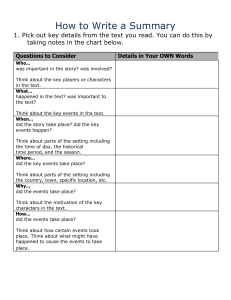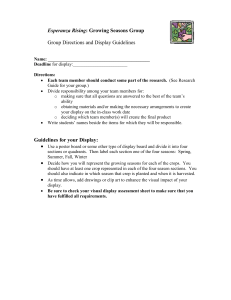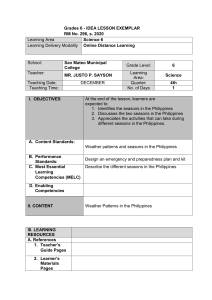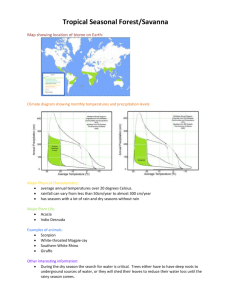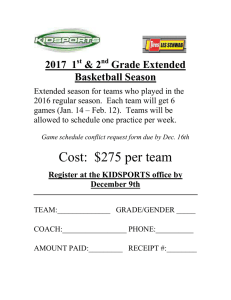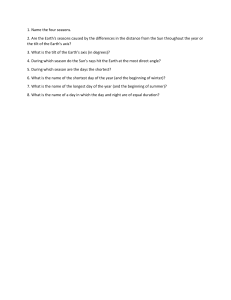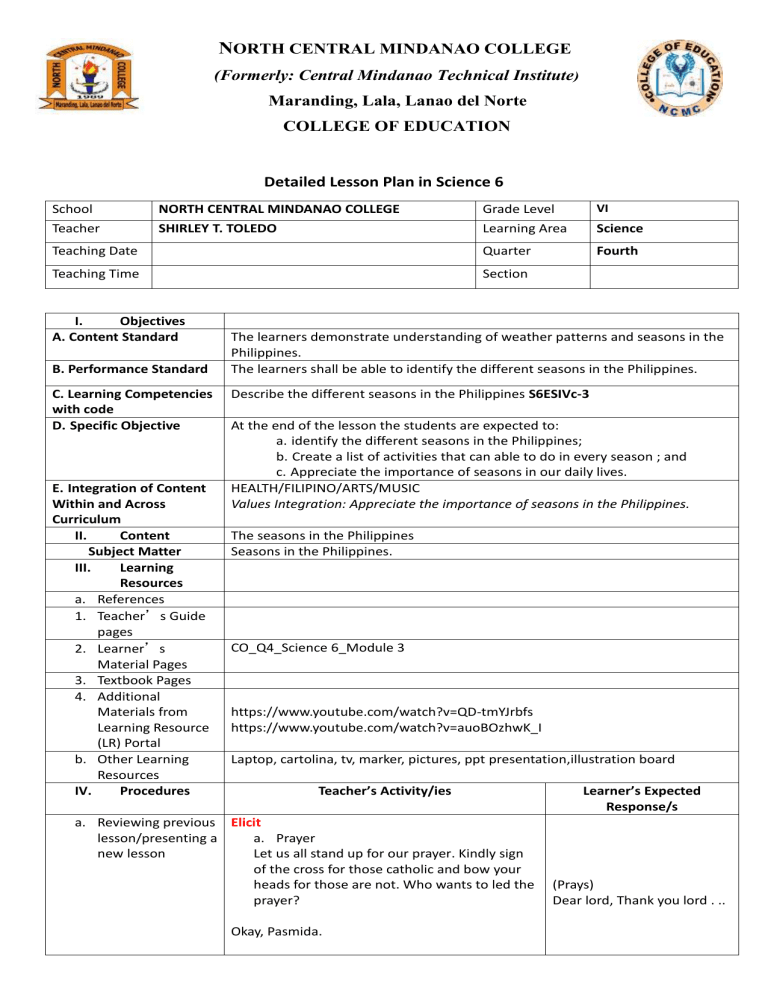
NORTH CENTRAL MINDANAO COLLEGE (Formerly: Central Mindanao Technical Institute) Maranding, Lala, Lanao del Norte COLLEGE OF EDUCATION Detailed Lesson Plan in Science 6 School NORTH CENTRAL MINDANAO COLLEGE Grade Level VI Teacher SHIRLEY T. TOLEDO Learning Area Science Teaching Date Quarter Fourth Teaching Time Section I. Objectives A. Content Standard B. Performance Standard C. Learning Competencies with code D. Specific Objective E. Integration of Content Within and Across Curriculum II. Content Subject Matter III. Learning Resources a. References 1. Teacher’s Guide pages 2. Learner’s Material Pages 3. Textbook Pages 4. Additional Materials from Learning Resource (LR) Portal b. Other Learning Resources IV. Procedures The learners demonstrate understanding of weather patterns and seasons in the Philippines. The learners shall be able to identify the different seasons in the Philippines. Describe the different seasons in the Philippines S6ESIVc-3 At the end of the lesson the students are expected to: a. identify the different seasons in the Philippines; b. Create a list of activities that can able to do in every season ; and c. Appreciate the importance of seasons in our daily lives. HEALTH/FILIPINO/ARTS/MUSIC Values Integration: Appreciate the importance of seasons in the Philippines. The seasons in the Philippines Seasons in the Philippines. CO_Q4_Science 6_Module 3 https://www.youtube.com/watch?v=QD-tmYJrbfs https://www.youtube.com/watch?v=auoBOzhwK_I Laptop, cartolina, tv, marker, pictures, ppt presentation,illustration board Teacher’s Activity/ies a. Reviewing previous Elicit lesson/presenting a a. Prayer new lesson Let us all stand up for our prayer. Kindly sign of the cross for those catholic and bow your heads for those are not. Who wants to led the prayer? Okay, Pasmida. Learner’s Expected Response/s (Prays) Dear lord, Thank you lord . .. VALUES INTEGRATION: Respect one’s others culture. Indicator 5: Maintain learning environments that promote fairness, respect and care to encourage learning b. Greetings Good morning Grade 6! How are you today? Good. By the way, my name is teacher Shirley and I will be your teacher for this morning. Good morning, teacher. Great teacher. HEALTH CHECK: Kindly put all your hands on the table. I will Students put nails on their check your nails if it is clean. Kindly, take-off your table face mask I will check your teeth also. c. Checking of Attendance Who is absent today? “Before we start, kindly pick some pieces of papers under your chairs and arrange your chairs properly” d. Checking of Assignment Do you have any assignments? Very good! e. Energizer So now, let us have an energizer first. Do you want an energizer class? None teacher. Pick up the papers and arranges chairs. None teacher. Yes teacher. https://www.youtube.com/watch?v=LrsaXkdK6OU f. Classroom Rules Alright, so before we proceed to our lesson proper, we have classroom rules that you need to follow in our class. 1. Sit properly. Hand in the table, feet down. 2. Listen attentively. 3. In our group activity choose one member of the group to be the leader, and the leader will raise his/her right hand if you will have questions/concerns. 4. In every group, you must to answer of what you have understand. 5. In our activity, the materials that we will use should be use for the intended activity only. Understand? Considering everybody’s safety. Indicator 4: Establish safe and secure learning environments to enhance learning through the consistent implementation of policies, guidelines, and procedures. g. Review Past Lesson Yes, Teacher. So let us now review our previous lesson. In the previous lessons, you have learned about what? Yes cheska. Very good! Now, let’s recall what they are. Who can share in the class of what is weather? Yes Vince? Magnificient! About weather and climate teacher. Weather is the condition of the atmosphere at a particular place over a short period of time. It can change from hour to hour and from one day to another. It is influenced by several factors like temperature (degree of hotness and coldness of the atmosphere), humidity (moisture content of the atmosphere) and precipitation (amount of rain falling over a specific area). In the other word weather is the word we use to describe how the sky looks and feels. These are examples of weather: So, what is the weather today class? Very good! So how about climate. What is climate? Yes Maruja? Very good! So, weather is the short variation of the atmosphere while climate is the weather condition over a long period of time. It’s sunny day teacher. Climate refers to the average weather pattern of a place over a long period of time (such as months and years) Alright so now since you already know of what was our last topic. Now, let us go forward to the other activity that I am prepare for you. Engage DRILL b. Establishing a purpose for the So now let us play a game! lesson This game is called “PICTOWORD”. In pictoword, the c. Presenting examples/instances player/student’s will read the two pictures to form a word. of the new lesson 1. + Answers: 1. Seafood + 2. 3. 4. 2. Keyboard 3. Footprint + 3. 4. Feedback + 5. Football 4. + 5. MOTIVATION Yes teacher. It is a tree teacher. Half of the tree teacher is alive while half is not. I think teacher is because of the season. So now, I will show you a picture, can you see this picture? What is in the picture class? Very good! Alright now based on the picture above what have you observed in the tree? Yes Sahara. Fabolous! Class, what do you think is the reason why the tree looks like that? Yes Ezrah. A. Identify the different seasons in the Philippines; B. Create a list of activities that can able to do in every seasons ; and C. Appreciate the importance of seasons in our daily lives. Precisely! Class, our topic for today is all about seasons in the Philippines and here are the objectives. d. Discussing new concepts and practicing new skills #1 Explore In the Philippines, we only have two seasons, namely; Wet season; and Dry season Two Types of Season 1. Wet season or rainy season- takes place from June to November. This is characterized by frequent rainfall, which may bring flood to the lowlands. Typhoons often hit the country during this season. (Pupils are listening) The wet season affects the activities of people. Farmers plant their crops during this season because the abundance of rainwater makes their crops grow quickly. People prefer to serve and eat warm foods as well as wear thick and long-sleeved clothes. During the wet season, people do most of their activities indoors. When going outdoors, they usually bring umbrellas and raincoats. (Pupils are listening) 2. Dry season- The dry season takes place during the months of December to May. This is characterized by less and infrequent rainfall as well as dusty soil. During this season, some of the crops die due to insufficient supply of water. (Pupils are listening) The dry season is influenced by the Northeast Monsoon or Hanging Amihan that brings cool and dry air. Hanging Amihan blows from the northeast portion of the country and causes slight to moderate rainfall in the eastern portion of the country. Now, why does the Philippines has two seasons only? Because the Philippines is located near the equator. Areas near or at the equator receive high amounts of sunlight due to the inclination of earth. The Earth's axis is tilted 23.5 degrees. This means that the Earth does not stand up straight as it rotates on its axis and revolves around the sun. Instead, it leans over a bit. Do you understand the lesson for today? e. Discussing new concepts and practicing new skills #2 Yes teacher, Indicator 1: Apply knowledge of content within and across curriculum teaching areas. Activity 1 (Group activity) So now, I will group you into two (2) groups. All you have to do is to identify what seasons is in the picture. Each group will be given materials where you write your answers. To answer, you will choose one of your group mates to raise the answer and the group that get more correct answers will be the winner. Understand? Yes teacher. (Learner centered activity) 1. Answers: 1. Wet season 2. Dry season 3. Wet season 2. 4. Wet season 5. Dry season 3. 4. 5. f. Developing mastery (Leads to Formative Assessment) Activity 2 Now, I want you to create a list that can able to do when dry and wet seasons. Instructions: Give 5 activities in dry season and 5 activities when wet season. DRY SEASON WET SEASON 1. 1. 2. 2. 3. 3. 4. 4. 5. 5. (Learner centered activity) Answers: DRY WET SEASON SEASON 1. swimmin 1. Wearing g of umbrellas 2.biking 2. wearing of rain coat 3.picnic 3. take a bath in the rain 4.paraglidi 4. catch ng raindrops on your tongue 5.water the plants g. Finding practical applications of concepts and skills in daily living Activity 3 So now, I will group you into three (3) groups and each group will have a differentiated activities. Understand? DIFFERENTIATED ACTIVITIES: GROUP 1: (Arts integration) Draw the two seasons in the Philippines GROUP 2 (Appreciate the importance of seasons in our daily lives) You will be given a pictures where you need to discuss/brainstorm along your group mates and select representative to discuss the picture in front of the class, he/she will discuss about what he/she have understand on the picture. GROUP 3 MAKE A SONG (MUSIC Integration) Write and express your feelings while you feel and experience the seasons. GROUP 4 Choose and encircle the letter of the correct answer. (Values integration) Plants can grow without different seasons? Yes teacher. 5.sing and dance in the rain A. Yes B. No C. Maybe h. Making generalizations and abstractions about the lesson Do you have any questions/clarifications? If you don’t have questions. Then, me I have a questions on you. Are you ready? What have you learned today? Yes Vince? Very good! None teacher. Yes teacher. I learned that there are two types of season in the Philippines namely, it is dry and wet season. In what months during dry season takes place? Yes Althea. Fabolous! From December to may teacher. How about during wet season? Yes Chad. Magneficient! From June to November teacher. Now can you share in the class of what is the importance of seasons in our daily lives? Yes Rheanne Mae. Precisely! The importance of seasons in our daily lives teacher is that more likely wet season has a good effect somehow especially to farmers because the more supplies of water helps their plants to grow quickly. Take note class, that seasons in the Philippines might have good effect somehow in our daily lives because like in dry season we can able to do more activities outdoor like, swimming at beach, wash and hung clothes outside , etc. .And wet season somehow also might give a big help to farmers positively because of the more supplies of rainwater helps their plant to grow quickly. Did you understand the lesson today? Good job everyone! Indicator 3: Use effective verbal and non-verbal classroom communication strategies to support learners understanding, participation, engagement and achievement. i. Evaluating Learning Evaluation Yes teacher. Directions: Write the letter of the correct answers only in a 1/4 sheet of paper. 1. What are the two types of season in the Philippines? a. Wet and dry season b. Autumn and dry season c. Autumn and wet season d. Autumn, wet and dry season Answers: 1. A 2. Wet season takes place during _________. a. January to February b. February to march c. March to April d. June to November 2. D 3. Dry season takes place during ___________. a. December to May b. June to July c. July to August d. August to September 4. A 3. A 5. D 4. Dry season starts in ____________. a. December b. January c. February d. March 5. Dry season ends in ___________. a. July b. August c. September d. May j. Additional activities for application or remediation Extend For scores 0-3 Cut-out pictures about different seasons in the Philippines and make a collage. Put it in a long bond-paper. For scores 4-5 In minimum of 100 words write the importance of seasons in the Philippines. V. REMARKS VI. REFLECTION A. No. Of learners who earned 80% in the evaluation _____Lesson carried. Move on to the next objective. _____Lesson not carried. _____% of the pupils got 80% mastery B. No. Of learners who _____Pupils did not find difficulties in answering their lesson. require additional _____Pupils found difficulties in answering their lesson. activities for _____Pupils did not enjoy the lesson because of lack of knowledge, skills and interest about the lesson. remediation who scored below 80% C. Did the remedial lessons work? No. Of learners who have caught up with the lesson D. No. Of learners who continue to require remediation E. Which of my teaching strategies worked well? Why did these work? _____Pupils were interested on the lesson, despite of some difficulties encountered in answering the questions asked by the teacher. _____Pupils mastered the lesson despite of limited resources used by the teacher. _____Majority of the pupils finished their work on time. _____Some pupils did not finish their work on time due to unnecessary behavior. _____of learners who earned 80% above _____of learners who require additional activities for remediation _____Yes _____No _____of learners who caught up the lesson Prepared by: SHIRLEY T. TOLEDO Student Teacher Checked by: TAMAR RUBILLAR Cooperating Teacher/Mentor Approved by: SABINIANA LAGANOSA School Principal
